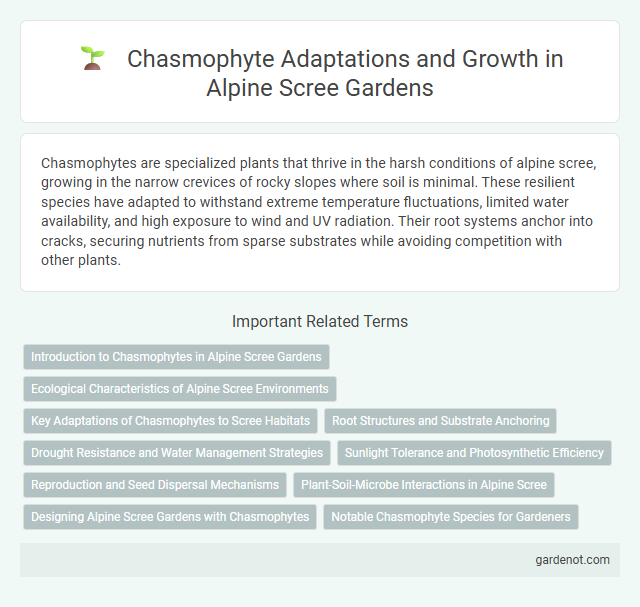Chasmophytes are specialized plants that thrive in the harsh conditions of alpine scree, growing in the narrow crevices of rocky slopes where soil is minimal. These resilient species have adapted to withstand extreme temperature fluctuations, limited water availability, and high exposure to wind and UV radiation. Their root systems anchor into cracks, securing nutrients from sparse substrates while avoiding competition with other plants.
Introduction to Chasmophytes in Alpine Scree Gardens
Chasmophytes are specialized plants adapted to survive in the harsh conditions of alpine scree gardens, thriving in narrow rock crevices with minimal soil and extreme temperature fluctuations. These resilient species exhibit unique root systems and water retention strategies, enabling them to anchor themselves firmly while withstanding drought and nutrient scarcity. Their presence in alpine scree contributes to biodiversity by stabilizing loose rocks and providing microhabitats for other organisms.
Ecological Characteristics of Alpine Scree Environments
Chasmophytes in alpine scree exhibit remarkable adaptations to extreme ecological conditions, including intolerance to nutrient-poor, unstable substrates and exposure to intense solar radiation. These specialized plants develop deep root systems and compact growth forms to anchor themselves within the rocky crevices and minimize water loss. Their physiological traits allow survival amid rapid temperature fluctuations and limited soil moisture typical of alpine scree habitats.
Key Adaptations of Chasmophytes to Scree Habitats
Chasmophytes exhibit specialized root systems that anchor them securely within the unstable, rocky crevices of alpine scree slopes, enabling efficient nutrient and water absorption despite minimal soil presence. Their physiological adaptations include drought tolerance and the ability to withstand temperature fluctuations, supporting survival in harsh, exposed microhabitats. Morphological traits such as compact growth forms and protective leaf structures reduce water loss and mitigate damage from wind and mechanical abrasion prevalent in scree environments.
Root Structures and Substrate Anchoring
Chasmophyte plants in alpine scree exhibit specialized root structures that penetrate deep into rock crevices, enhancing stability and nutrient absorption. These roots often develop tough, fibrous tissues that anchor firmly within fragmented substrates, preventing displacement by strong winds and erosion. Efficient substrate anchoring allows chasmophytes to survive in nutrient-poor, unstable scree environments characteristic of high-altitude ecosystems.
Drought Resistance and Water Management Strategies
Chasmophytes in alpine scree exhibit remarkable drought resistance by developing specialized root systems that penetrate deep crevices to access scarce moisture. These plants minimize water loss through reduced leaf surface area and a thick, waxy cuticle that limits transpiration. Their ability to store water in succulent tissues further enhances survival in the arid, well-drained scree environment.
Sunlight Tolerance and Photosynthetic Efficiency
Chasmophytes thriving in alpine scree exhibit exceptional sunlight tolerance, adapting to intense solar radiation found at high elevations. Their photosynthetic efficiency is optimized through specialized pigments and leaf structures that minimize photoinhibition while maximizing light absorption. This adaptation allows chasmophytes to sustain carbon fixation and growth despite fluctuating light conditions and harsh alpine environments.
Reproduction and Seed Dispersal Mechanisms
Chasmophytes in alpine scree reproduce primarily through sexual reproduction, producing seeds adapted to harsh, rocky environments. Their seeds often possess specialized structures such as wings or hairs that facilitate wind dispersal, ensuring colonization in crevices and loose scree substrates. Some species also rely on gravity and water movement to transport seeds further into suitable microhabitats, enhancing survival and establishment.
Plant-Soil-Microbe Interactions in Alpine Scree
Chasmophytes in alpine scree exhibit specialized plant-soil-microbe interactions crucial for survival in nutrient-poor, rocky substrates. These plants foster symbiotic relationships with mycorrhizal fungi and nitrogen-fixing bacteria, enhancing nutrient uptake and soil stabilization in harsh alpine environments. Microbial communities facilitate organic matter decomposition and nutrient cycling, optimizing resource availability for chasmophyte growth on scree slopes.
Designing Alpine Scree Gardens with Chasmophytes
Chasmophytes thrive in alpine scree gardens by anchoring themselves within rock crevices, making them ideal for stabilizing loose scree substrates. Selecting species such as Saxifraga and Sedum allows for efficient water retention and resilience against harsh mountain winds and temperature fluctuations. Designing with chasmophytes enhances biodiversity while mimicking natural alpine ecosystems, promoting sustainable garden environments.
Notable Chasmophyte Species for Gardeners
Notable chasmophyte species for gardeners include Saxifraga paniculata, known for its resilient rosettes and delicate white blossoms thriving in rocky crevices. Sedum album offers succulent leaves and star-shaped flowers ideal for alpine scree gardens with excellent drought tolerance. Campanula cochleariifolia features bell-shaped blue flowers that attract pollinators while adapting well to well-drained, stony soils common in chasmophyte habitats.
Chasmophyte Infographic

 gardenot.com
gardenot.com